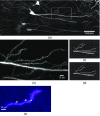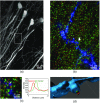Light-sheet fluorescence expansion microscopy: fast mapping of neural circuits at super resolution
- PMID: 30796881
- PMCID: PMC6368534
- DOI: 10.1117/1.NPh.6.1.015005
Light-sheet fluorescence expansion microscopy: fast mapping of neural circuits at super resolution
Abstract
The goal of understanding the architecture of neural circuits at the synapse level with a brain-wide perspective has powered the interest in high-speed and large field-of-view volumetric imaging at subcellular resolution. Here, we developed a method combining tissue expansion and light-sheet fluorescence microscopy to allow extended volumetric super resolution high-speed imaging of large mouse brain samples. We demonstrate the capabilities of this method by performing two color fast volumetric super resolution imaging of mouse CA1 and dentate gyrus molecular-, granule cell-, and polymorphic layers. Our method enables an exact evaluation of granule cell and neurite morphology within the context of large cell ensembles spanning several orders of magnitude in resolution. We found that imaging a brain region of in super resolution using light-sheet fluorescence expansion microscopy is about 17-fold faster than imaging the same region by a current state-of-the-art high-resolution confocal laser scanning microscope.
Keywords: connectomics; dentate gyrus; light-sheet fluorescence microscopy; super resolution; tissue expansion.
Figures






Similar articles
-
SPED Light Sheet Microscopy: Fast Mapping of Biological System Structure and Function.Cell. 2015 Dec 17;163(7):1796-806. doi: 10.1016/j.cell.2015.11.061. Cell. 2015. PMID: 26687363 Free PMC article.
-
Deep-learning super-resolution light-sheet add-on microscopy (Deep-SLAM) for easy isotropic volumetric imaging of large biological specimens.Biomed Opt Express. 2020 Nov 23;11(12):7273-7285. doi: 10.1364/BOE.409732. eCollection 2020 Dec 1. Biomed Opt Express. 2020. PMID: 33408995 Free PMC article.
-
Two-photon light-sheet nanoscopy by fluorescence fluctuation correlation analysis.Nanoscale. 2016 May 21;8(19):9982-7. doi: 10.1039/c6nr00324a. Epub 2016 Apr 28. Nanoscale. 2016. PMID: 27121341
-
Tissue Clearing and Expansion Methods for Imaging Brain Pathology in Neurodegeneration: From Circuits to Synapses and Beyond.Front Neurosci. 2020 Oct 5;14:914. doi: 10.3389/fnins.2020.00914. eCollection 2020. Front Neurosci. 2020. PMID: 33122983 Free PMC article. Review.
-
Single-molecule super-resolution light-sheet microscopy.Chemphyschem. 2014 Mar 17;15(4):577-86. doi: 10.1002/cphc.201300732. Epub 2014 Feb 25. Chemphyschem. 2014. PMID: 24615819 Review.
Cited by
-
Light Sheet Illumination for 3D Single-Molecule Super-Resolution Imaging of Neuronal Synapses.Front Synaptic Neurosci. 2021 Nov 24;13:761530. doi: 10.3389/fnsyn.2021.761530. eCollection 2021. Front Synaptic Neurosci. 2021. PMID: 34899261 Free PMC article. Review.
-
Expansion tomography for large volume tissue imaging with nanoscale resolution.Biomed Opt Express. 2021 Aug 13;12(9):5614-5628. doi: 10.1364/BOE.431696. eCollection 2021 Sep 1. Biomed Opt Express. 2021. PMID: 34692204 Free PMC article.
-
Scalable and Isotropic Expansion of Tissues with Simply Tunable Expansion Ratio.Adv Sci (Weinh). 2019 Sep 30;6(22):1901673. doi: 10.1002/advs.201901673. eCollection 2019 Nov. Adv Sci (Weinh). 2019. PMID: 31763149 Free PMC article.
-
Intrinsic and Synaptic Contributions to Repetitive Spiking in Dentate Granule Cells.J Neurosci. 2024 May 1;44(18):e0716232024. doi: 10.1523/JNEUROSCI.0716-23.2024. J Neurosci. 2024. PMID: 38503495 Free PMC article.
-
Comparison of Different Tissue Clearing Methods for Three-Dimensional Reconstruction of Human Brain Cellular Anatomy Using Advanced Imaging Techniques.Front Neuroanat. 2021 Nov 11;15:752234. doi: 10.3389/fnana.2021.752234. eCollection 2021. Front Neuroanat. 2021. PMID: 34867215 Free PMC article.
References
-
- Ramón S., Cajal Y., Textura del sistema nervioso del hombre y de los vertebrados, Imprenta y Librería de Nicolás Moya, Madrid: (1899–1904).
LinkOut - more resources
Full Text Sources
Other Literature Sources
Molecular Biology Databases
Miscellaneous

